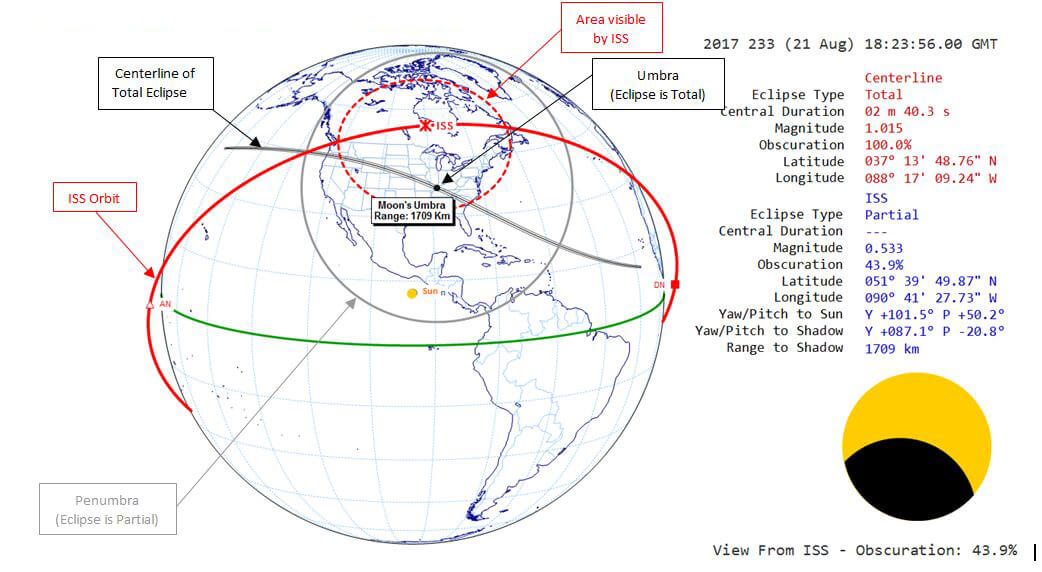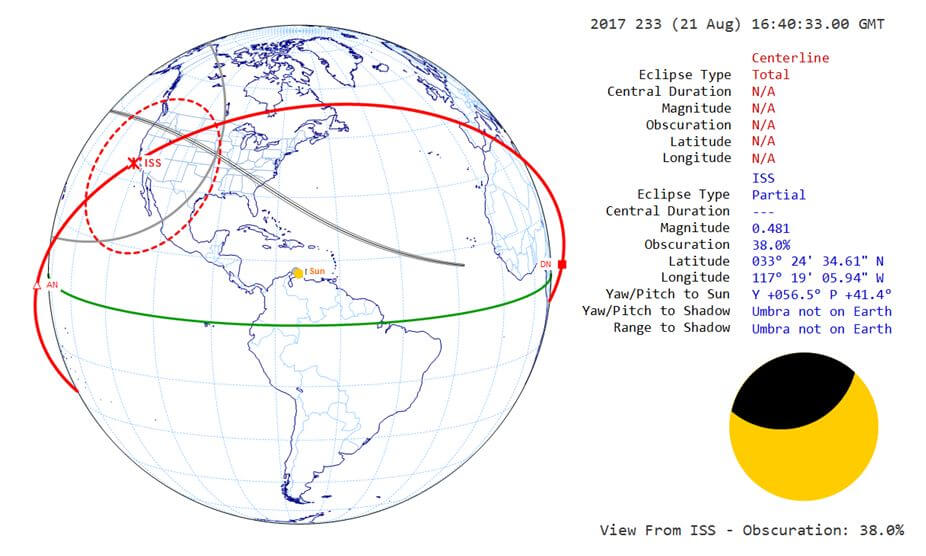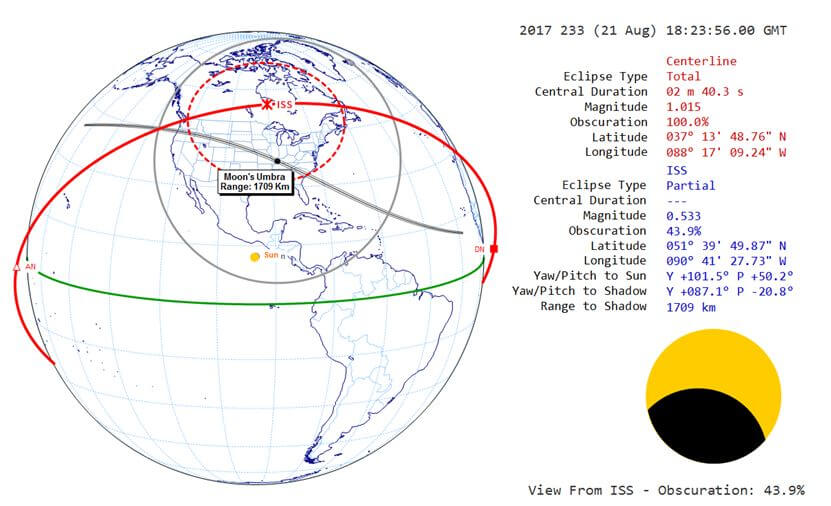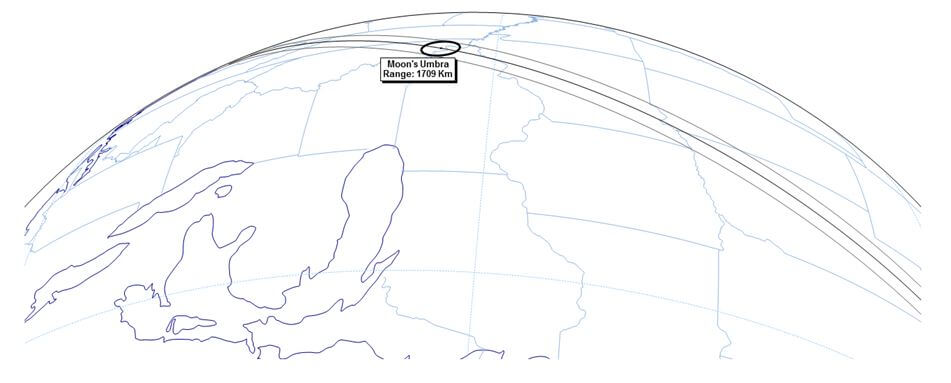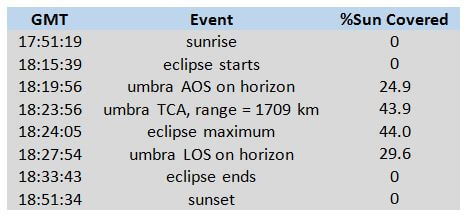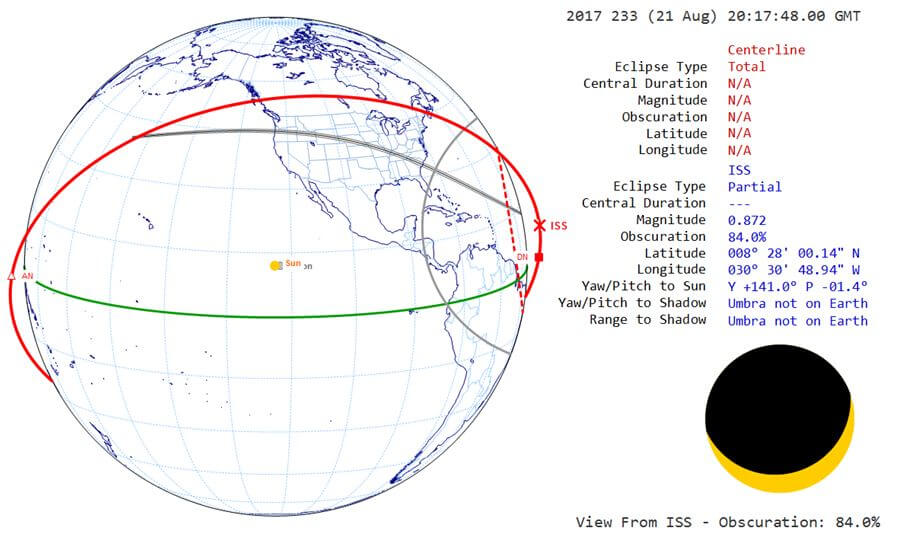ISS Observations
On August 21, 2017, a total solar eclipse will occur with the path of totality cutting across the lower 48 states from Oregon to South Carolina. There has been interest in what ISS will be able to view of this event. This write-up outlines the general visibility of the eclipse viewed from ISS’s perspective, including whether or not the Moon’s central umbra shadow is visible on the Earth’s surface. ISS crew visibility with respect to ISS structural blockage is not taken into account. TOPO has supplied the ISS trajectory and the Moon’s umbra time history to POINTING for them to determine the best windows for viewing the eclipse directly or the Moon’s shadow on the Earth’s surface as well as option for viewing the eclipse directly. Please see their analysis.
There has also been interest in knowing where on the ground one may witness the ISS transit the sun during the partial or total phases of the eclipse. While TOPO does not have software specifically designed to calculate ISS transits, some general guidance on ISS solar transits is given.
During this eclipse, ISS will pass through the Moon’s penumbra shadow three times, experiencing a partial solar eclipse from its point of view each time. ISS will not pass through the Moon’s umbra and therefore will not experience a total solar eclipse from orbit.
For each pass, a general description of each pass, a table of event times, and one or more figures are shown of the location of ISS at the mid-point of each pass. An example graphic figure is shown on the next page with a description of some of the features depicted.
Description of Graphics
An example figure of a pass is shown below. This particular example figure shows the view of the Earth from the Sun’s perspective at 18:23:56 GMT on 21-August.
ISS’s orbit around the Earth is represented by a solid red circle with ISS’s current position marked and labeled as “ISS”.
The portion of the Earth that ISS can see from its vantage point in orbit is marked by the red dotted circular region.
The path that the Moon’s central umbra shadow will follow during the eclipse is drawn by the solid black line that crosses from the Pacific Ocean, across the United States from Oregon to South Carolina, and out over the Atlantic Ocean.
The outline of the Moon’s umbra shadow (where there is no sunlight) is shown at its current position drawn on the Earth’s surface if it is visible as a small black outline. If the umbra shadow on the Earth is also visible from ISS, the distance to the center point is also given. For the example below, the umbra is over southwestern Kentucky and is visible from ISS at a distance of 1709 km. The outer penumbra shadow (where a partial solar eclipse is seen on Earth) is also shown as a light gray outline.
In the bottom right-hand corner, the relative position of the Moon with respect to the Sun is given along with the current obscuration of the Sun by the Moon as viewed from ISS. In this example, 43.9% of the Sun is being blocked (obscured) by the Moon.
The following pages will give specific details for each pass.
ISS Transits Across the Sun During the Eclipse
TOPO software does not currently calculate ISS transit opportunities across any celestial object. However, there are two online calculators that are popular with the ISS transit community, https://www.calsky.com and http://transit-finder.com. While TOPO cannot verify the accuracy of either of these websites, they appear to be successful based on the user galleries seen online.
This author can only recommend that if one chooses to use one of these sites, that you frequently check the ground track position predictions for your precise viewing position and adjust accordingly. The predictions are very sensitive to the accuracy of the ISS trajectory so it is vital for the tool to have used the most recent data.
Pass #1:
During the first pass through the Moon’s penumbra, ISS will experience a partial solar eclipse with 38.0% of the Sun covered up at maximum. ISS will not see the Moon’s umbra on the Earth’s surface.
ISS passes over the western United States and southeastern Canada during this pass. See figure below representing ISS’s location at maximum eclipse. At the time of the figure (16:40:33 GMT), the total portion of the eclipse has not yet started for the Earth. A partial eclipse is already in progress and is witnessed by ISS.
See table below for event times for this pass.
ISS Transit Across the Sun
While an ISS transit of the Sun will occur over a very thin ground track from California through Canada, only at the intersection of this transit path with the Moon’s shadow path in Wyoming can one stay in one place and witness both a transit of the ISS across the partially eclipsed Sun and the total solar eclipse later in the morning. TOPO recommends checking the recommended websites mentioned earlier in this write-up for location.
Pass #2:
ISS will experience a partial solar eclipse with 43.9% of the Sun covered up at maximum. Also, ISS will witness the Moon’s umbra moving through southern Illinois and southwestern Kentucky during a portion of this pass while ISS traverses over southern Canada At the umbra’s closest approach, ISS will be just south of the Hudson Bay while the Moon’s umbra shadow is located in southwestern Kentucky just over 1700 km away. While ISS does not pass near the location of the Moon’s umbra, the Moon’s umbra will be easily visible near the horizon.
The figures below show the ISS at the mid-point of the eclipse during this pass from the perspective of the Sun and from a perspective of ISS itself, looking ISS-starboard.
ISS Transit Across the Sun
While an ISS transit of the Sun will occur over a very thin ground track from Washington through Canada, there is not a single location on land where one can witness an ISS transit during this pass and the total solar eclipse. This intersection occurs over the Pacific Ocean.
Pass #3:
During the third pass through the Moon’s penumbra, ISS will experience a partial solar eclipse with 84% of the Sun covered up at the maximum point a few minutes prior to orbital sunset. ISS will not see the Moon’s umbra on the Earth surface since the umbra will have just lifted off the Earth’s surface a few minutes prior to the start of ISS’s eclipse on this pass.
However, this pass offers the opportunity to see the Sun partially eclipsed as it sets into the atmosphere with 26.7% of the Sun covered by the Moon (assuming no structural blockage).
The figure below represents ISS’s location at maximum eclipse, which occurs a few minutes prior to sunset, as viewed from the Sun.
See table below for event times for this pass.
ISS Transit Across the Sun
While an ISS transit of the Sun will occur over a very thin ground track across Canada during this pass, there is not a single location on land where one can witness an ISS transit during this pass and the total solar eclipse. This intersection occurs over the Pacific Ocean.
